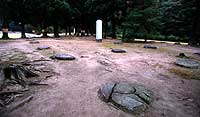
| Designation | Nationally-Designated |
|---|---|
| Classification | Special Historical Sight |
| Designated Date | October 12, 1922 |
| Designated Date in detail | October 12, 1922 November 22, 1952 changed to Special historical sight July 14, 2005 added, and change the title |
| Amount | |
| Address | Aza-Osawa, Hiraizumi |
| Holder | Hiraizumi etc. |
| Retainer | |
| Administrator | |
| HomePage | Hiraizumi's Cultural Heritage |
Summary
According to the temple document, Moutsu-ji was founded in 850 by Jikaku Daishi(a high-ranking priest). Later, it was expanded and enriched in the time of Motohira the second, and Hidehira the third of Fujiwara lord.
These construction complex consists in Kondo-Enryuji temple, Jougyou-do, the two-storied main entrance gate, the bell tower, Kyozo (a sutra repository), Kisshou-do, Senju-do, Kashou-ji temple and Kanjizaio-in, and all together 409 temples and pagodas, over 500 priest’s residences. Unfortunately, whole building sites was lost by fire.
Only the foundation stones of these buidings and some garden rocks are remained now, and showing redolent of good old days.
The south gate has the base stone remained, the ridge width is 5.4 meter, length in the cross beam of roof ridge is 4.7 meter, length between the purlin is 4 meter.
Split stone paving were found which used to be the pedestal of statues called Kongou-Rikishi (Niou=guardians of the temple) in the southeast side.
There used to be two bridges in the middle island of O-izumigaike (Great Spring Pond), one was connected to south and the other connected to north. There is Kondo-Enryu-ji Temple with shinden-dukuri (aristocratic style mansions) in the north part of the bridge, and the foundation stone of Kashou-ji Temple in the west.
Within the designated site, there is the remain site of Kanjizaio-in Temple. It was commissioned by the wife of the second Fujiwara lord Motohira. The pond in this site, as well as the garden of Motsu-ji Temple, represents the earthly paradise as the traditional Pure Land garden.
After the excavation and research, it has been restored the original classical style of Heian era.
